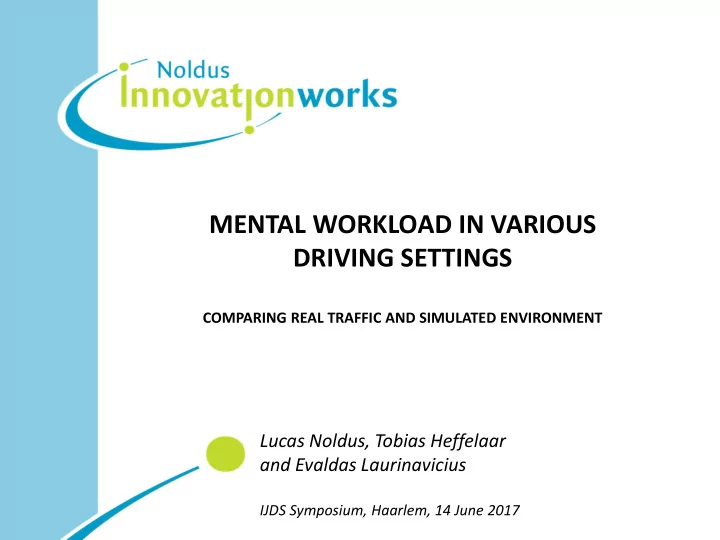

MENTAL WORKLOAD IN VARIOUS DRIVING SETTINGS COMPARING REAL TRAFFIC AND SIMULATED ENVIRONMENT Lucas Noldus, Tobias Heffelaar and Evaldas Laurinavicius IJDS Symposium, Haarlem, 14 June 2017
Mental workload during driving Factors contributing to mental workload ● Traffic density ● Road signs ● Information systems in or on the dashboard ● Communication devices
Background Measuring mental workload • Efficient estimation of mental workload is important because of the high number of accidents associated with elevated mental workload • Developments in the fields of autonomous vehicles and driver-vehicle interface design require better insight in workload during driving • Integrated approach: combining multiple measurements to ensure reliable workload estimation across driving conditions
How to assess mental workload? Physiological measures: • Pupil dilation • Blink rate and duration • Scan patterns • Galvanic skin conductance Performance based measures: • Lateral driving • Steering reversal rate • Headway (Ganguly, 2012)
Instrumented car ADVICE project Eye tracker
Real car or simulator? Simulator compared to real car: • Safer • Better control of experimental conditions (type, sequence, duration, randomization) • Less realistic Research question: • How do mental workload measurements in a car simulator compare to measurements in a real car?
DriveLab ™ Integrated test environment for driving studies
DriveLab experimental setup ● Stationary driving simulator ● SILAB driving simulation software (WIVW) ● Smart Eye Pro eye tracker ● TMSi Mobita amplifier + GSR electrodes ● Video camera + Media Recorder software ● The Observer XT software ● N-Linx communication software
DriveLab The Observer XT • Control of the experiment • Automatic import and synchronization of all data streams • Visualization of the collected data • Data selection and analysis • Possibility to add manually coded behaviors to the analysis
Experiment design • Data from instrumented vehicle o ADVICE project 2015 (van Leeuwen et al., 2017), N=6 • DriveLab experiment o N=21 (at least 2 years of driving experience) o Compare responses in a fixed time window before and after stimulus (countback task) o Recreating road segments of ADVICE experiment o Experimental route with different road segments: Town Straight, Town Junction, Highway, Rural Straight, Rural Junction
Methods • Cognitive Load task: Count Back Task in steps of 3 • 4-second window (=240 samples) before and after stimulus • 60% pupil diameter quality threshold: samples with pupil diameter quality < 0.6 (Smart Eye) are removed from analysis • 60% required sample criterion: segments with less than 144 samples are removed from the analysis • Total number of segments measured: 270 • Number of segments analyzed (after quality and sample count filter): 151
Results: Pupil diameter Mean pupil diameter values (mm) in the simulator before and after cognitive load task (CL) Pupil diameter between the conditions (No CL /CL) in the simulator 5,0000 * 4,5000 4,0000 3,5000 3,0000 2,5000 2,0000 1,5000 1,0000 0,5000 0,0000 Town Town Rural Rural Highway Town Town Rural Rural Highway Junction Straight Junction Straight Junction Straight Junction Straight (CL) (CL) (CL) (CL) (CL) Town Junction Town Straight Rural Junction Rural Straight Highway Sig. .575 .009 .932 .172 .735
Results: Pupil diameter Mean pupil diameter values (mm) in the car before and after cognitive load task (CL) Pupil diameter between the conditions (No CL /CL) in the car 3,0000 2,5000 2,0000 1,5000 1,0000 0,5000 0,0000 Town Town Rural Rural Highway Town Town Rural Rural Highway Junction Straight Junction Straight Junction Straight Junction Straight (CL) (CL) (CL) (CL) (CL) Town Junction Town Straight Rural Junction Rural Straight Highway Sig. .180 .157 .655 .180 .180
Results: Pupil diameter Mean pupil diameter values pre and post stimuli Mean pupil diameter pre and post stimuli on the Highway Segment Mean Mean Highway (mm) (mm) Road Segment Environment 3,80 3,76 4,00 pre post 3,50 Town Junction simulator 3.75 3.80 3,00 car 2.48 2.28 2,50 2,12 2,02 Town Straight simulator 3.54 3.62 2,00 car 2.09 1.99 1,50 Rural Junction simulator 3.44 3.64 1,00 car 2.27 2.34 0,50 Rural Straight simulator 3.43 3.40 0,00 pre post car 2.12 2.03 Highway simulator car simulator 3.76 3.80 car 2.12 2.02 Town Town Rural Rural Town Town Rural Rural Highway Highway Junction Straight Junction Straight Junction Straight Junction Straight (CL) (CL) (CL) (CL) (CL) Sig. .009 .003 .013 .009 .030 .028 .027 .025 .026 .009
Results: Pupil diameter Mean pupil diameter pre and post stimuli on different road segments (both environments) Rural Junction Rural Straight 3,64 3,44 3,43 3,40 4,00 4,00 3,50 3,50 3,00 3,00 2,34 2,27 2,12 2,03 2,50 2,50 2,00 2,00 1,50 1,50 1,00 1,00 0,50 0,50 0,00 0,00 pre post pre post simulator car simulator car Town Straight Town Junction 3,80 3,75 3,62 3,54 4,00 4,00 3,50 3,50 2,48 3,00 3,00 2,28 2,09 1,99 2,50 2,50 2,00 2,00 1,50 1,50 1,00 1,00 0,50 0,50 0,00 0,00 pre post pre post simulator car simulator car
Conclusions and Discussion Main results • Pupil diameter during driving in a simulator is significantly larger than during driving in a real car, most likely due to different light conditions • Cognitive load task resulted in increased pupil dilation in only one test condition (road segment Town Straight) in the simulator • Similar behavioral strategies were observed while driving and experiencing higher cognitive demands (e.g. slow down counting or postpone it on more difficult segments) in both environments Possible causes of inconsistent results ● Different sequencing of the segments and gained experience between car and simulator ● Relatively low number of test subjects ● Changes in environmental light (noise) Galvanic skin conductance and steering reversal data can further complement pupil diameter findings and provide a more complete estimate (analysis in progress)
Thank you Partners: ADVICE partners:
Recommend
More recommend